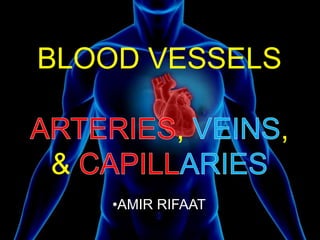Blood vessels: Arteries, Veins and Capillaries
•Download as PPTX, PDF•
85 likes•55,847 views
It is one of the circulatory systems. This explains the roles of arteries, veins and capillaries. It also differentiate between the arteries, veins and capillaries. This slide also explained the pulmonary circuit and systemic curcuit. This is an interesting notes and easy to be understand.
Report
Share
Report
Share

Recommended
Recommended
More Related Content
What's hot
What's hot (20)
14.structure & functions of capillaries, venules and veins 

14.structure & functions of capillaries, venules and veins
Viewers also liked (7)
Similar to Blood vessels: Arteries, Veins and Capillaries
Similar to Blood vessels: Arteries, Veins and Capillaries (20)
Artery and veins, capillaries, arteriole and venules, systemic circulation an...

Artery and veins, capillaries, arteriole and venules, systemic circulation an...
Organ system for internal transport (circulatory system)

Organ system for internal transport (circulatory system)
Recently uploaded
Recently uploaded (20)
Module for Grade 9 for Asynchronous/Distance learning

Module for Grade 9 for Asynchronous/Distance learning
Selaginella: features, morphology ,anatomy and reproduction.

Selaginella: features, morphology ,anatomy and reproduction.
Pteris : features, anatomy, morphology and lifecycle

Pteris : features, anatomy, morphology and lifecycle
Climate Change Impacts on Terrestrial and Aquatic Ecosystems.pptx

Climate Change Impacts on Terrestrial and Aquatic Ecosystems.pptx
Understanding Partial Differential Equations: Types and Solution Methods

Understanding Partial Differential Equations: Types and Solution Methods
Cot curve, melting temperature, unique and repetitive DNA

Cot curve, melting temperature, unique and repetitive DNA
Site specific recombination and transposition.........pdf

Site specific recombination and transposition.........pdf
TransientOffsetin14CAftertheCarringtonEventRecordedbyPolarTreeRings

TransientOffsetin14CAftertheCarringtonEventRecordedbyPolarTreeRings
FAIRSpectra - Enabling the FAIRification of Spectroscopy and Spectrometry

FAIRSpectra - Enabling the FAIRification of Spectroscopy and Spectrometry
development of diagnostic enzyme assay to detect leuser virus

development of diagnostic enzyme assay to detect leuser virus
Human & Veterinary Respiratory Physilogy_DR.E.Muralinath_Associate Professor....

Human & Veterinary Respiratory Physilogy_DR.E.Muralinath_Associate Professor....
X-rays from a Central “Exhaust Vent” of the Galactic Center Chimney

X-rays from a Central “Exhaust Vent” of the Galactic Center Chimney
Use of mutants in understanding seedling development.pptx

Use of mutants in understanding seedling development.pptx
Blood vessels: Arteries, Veins and Capillaries
- 1. BLOOD VESSELS , , & •AMIR RIFAAT
- 2. 3 major types Arteries Capillaries Veins 2 sub-types Arterioles Venules 60,000 miles or 100,000km of blood vessels
- 4. • As the heart contracts, it forces blood into the large arteries leaving the ventricles. • The blood then move to smaller arteries, finally reaching their smallest branches, the arterioles (little arteries), which feed into the capillary beds (collection of capillaries) of body organs and tissues. • Blood drains from the capillaries into venules (little veins), and then on into larger and larger veins that merge to form the large veins that ultimately empty into the heart. HEART ARTERY ARTERIOLE CAPILLARY VENULEVEIN
- 5. • Carry blood away from the heart. • “Branch” or “diverge” as they form smaller and smaller division. • Thick-walls to withstand pressure produced when heart pushes blood into the arteries. Elastic fibers (tunica media) allow the artery to stretch under pressure. • Aorta: Largest artery vessels • Arteriole: Smallest artery vessel that connect arteries to capillaries Pulmonary circulation • Carry poor oxygen blood from heart to the lungs. Systemic circulation • Carry rich oxygen blood from heart to the organs and tissues.
- 6. • Carry blood toward the heart. • “Join” or “merge” into successfully larger vessels approaching the heart. • Have valves which act to stop the blood from going in the wrong direction. • Body muscles surround the veins so that when the muscles contract, the veins are squeeze and the blood been pushed along the vessels. • Vena cava: SVC (blood from upper body) & IVC (blood from lower body. • Venules: Smallest vein vessels that connect veins to capillaries Pulmonary circulation • Carry rich oxygen blood from lungs to the heart Systemic circulation • Carry poor oxygen blood from capillaries to the heart
- 8. • Connect arteries and veins. • Contact tissue cells and directly serve cellular needs. • Exchange between blood and tissue cells occur. • Exchange: • Drop off oxygen and nutrients from heart by arteries • Pick up CO2 and other waste products and send to heart by veins . • Walls are one cell thick and very narrow.
- 9. • Flow of blood from arteriole to venule = microcirculation • Capillary beds consist of two types of vessels: 1. Vascular shunt: metarteriole-thoroughfare channel (short vessel that directly connect arteriole and venule. 2. True capillaries: actual exchange vessels. • Metarteriole: Vessel structurally intermediate between arteriole and capillary. • Thoroughfare channel: Vessel structurally intermediate between capillary and venule. • Precapillary sphincters: Surround the root of each true capillaries at the metarteriole and act as a valve.
- 10. 1. Blood flowing through the terminal arteriole may go either through the true capillaries or vascular shunt. 2. It is depend on the precapillary sphincters. 3. Sphincter open (relax): Blood flow through the true capillaries and takes part in gas exchange with tissue cells. • The terminal arteriole feeding the bed leads into true capillaries and joins at postcapillary venule that drains the bed. 4. Sphincter close (contract): Blood flow through the vascular shunt and bypasses the tissue cells. • The terminal arteriole feeding the bed leads into metarteriole and continue to thoroughfare channel and joins at postcapillary venule that drains the bed.
- 15. 1. Right ventricle pumps deoxygenated blood through pulmonary artery to the lungs. 2. The blood picks up 02 from the lungs and dumps CO2 into the lungs. 3. Oxygenated blood returned to the left atrium thru the pulmonary vein. 4. From the diagram, the pulmonary circuit happen from number 1 until number 4. 1. Oxygenated blood is pumped from left ventricle to the body (upper and lower) thru aorta. 2. Blood dumps oxygen into tissues and picks up CO2. 3. Deoxygenated blood travels from body to vena cava (SVC & IVC) to the right atrium. 4. From the diagram, the systemic circuit happen from number 5 until number 11.
